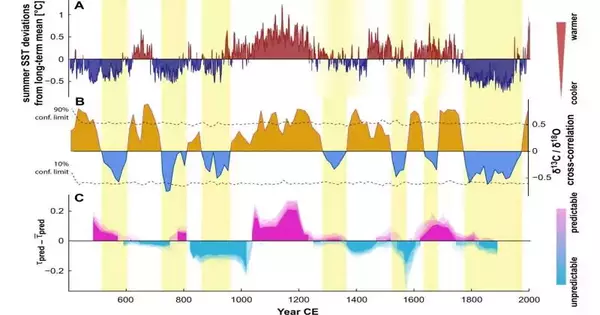Reduced seasonal rainfall predictability may have been a major factor in the collapse of the Classic Maya societies around 1,100 years ago. According to a new study recently published in Communications Earth and Environment, “Declines in seasonal predictability potentially destabilized Classic Maya societies.”.
Keith Prufer, an archaeologist at the University of New Mexico, as well as associates from the Potsdam Institute for Climate Impact Research (PIK) and Potsdam University are some of the authors. For the people in the area currently experiencing climate change, the findings might be important.
The research team examined changes in the stable isotope signatures of a stalagmite found in a cave in Belize, close to an ancient site in what was once the Maya’s heartland. The carbon and oxygen isotope ratios are sensitive indicators of the dynamics of local and regional precipitation.
“The climate record was derived from Yok Balum, a cave near the ancient Maya city of Uxbenká.” This ancient city is extensively included in this article since it is the closest to the location of the climatic data and because of two decades of research there on the time of the collapse.”
University of New Mexico archaeologist Keith Prufer.
This paper continues 18 years of investigation into past climate in the Belizean tropics by Prufer, UNM associates, and a global team of scientists.
The climate data was gathered from the Yok Balum cave, which is close to the historic Maya city of Uxbenká. According to Prufer, the significance of that historic city, which is highlighted in this article, can be attributed to both its proximity to the location of the climate data as well as the 20 years of research that have been conducted there to determine when the collapse occurred.
In order to understand the seasonal variation patterning, this paper is a collaboration with the Potsdam Institute for Climate Impact Research in Germany. Tobias Braun, the PIK lead, used this study as the basis for his dissertation.
The research team from UNM also consists of Ph. D. Erin Ray, a prospective student, and Victor Polyak, a senior research scientist in the UNM Department of Earth and Planetary Science. Ray put together cultural and demographic data, including information on the Maya’s dynastic history as recorded in their hieroglyphs. The high-precision chronology for the climate and seasonality records was first developed by Polyak.
The timely arrival of adequate rainfall was a crucial component of Maya agriculture. Since freshwater is only accessible during the summer monsoon season, farming is difficult in subtropical Central America. In a PIK press release about the recently released study, Braun noted that changes in the rainy season’s onset and intensity could have significant effects on Central American societies. Although the majority of scientists concur that population dispersal and urban center fragmentation in lowland Maya societies were largely caused by repeated intense droughts, there has been a lack of evidence on the seasonal time scale. And this is the main subject of the study.
Prufer claims that there are three reasons why this record is significant.
“First, it is a novel climate record for the American tropics with such high resolution—one to seven samples per year over a 1,600-year period—allowing us to examine changes in seasonality from year to year. It is also the first record of its kind to include sophisticated time series modeling to assess seasonal variation in the Neotropics and directly connect those changes to quantitative cultural records, according to Prufer.
Second, the study adds to our understanding of a persistent mystery in Maya archaeology: what led to the population decline and collapse of political institutions at the end of the Classic Period, between 250 and 850 CE?
The timing of planting, harvesting, and other agricultural activities would have become much more difficult—or impossible—to predict from year to year if seasonality had changed in this region, where all agriculture is directly dependent on rainfall.
The collapse, he said, “was significant.”. A complete form of governance was abandoned over the course of perhaps 100 to 150 years, and populations as high as 5 to 10 million people experienced a 60 to 70 percent decline.”.
The research is important for modern farming, which is the third point. The past serves as a guide for what to anticipate in a grim future.
Prufer noted that seasonality patterns are once again much less predictable than they were just a few decades ago due to modern global climate change. “Given their dependence on the timing of the rainy season and the seasonal distribution of rainfall, which are no longer predictable, this is forcing modern Maya farming communities—and everyone else—to rethink how they produce food and how to achieve food security.
This is crucial because farming requires a consistent amount of rainfall every season in addition to traditional knowledge of when to clear fields and plant. Food shortages and suffering for people result when this fails. This case study has ramifications for collective responses to climate change throughout the tropical regions of the world, which provide food for over 2 billion people.
More information: Tobias Braun et al, Decline in seasonal predictability potentially destabilized Classic Maya societies, Communications Earth & Environment (2023). DOI: 10.1038/s43247-023-00717-5





